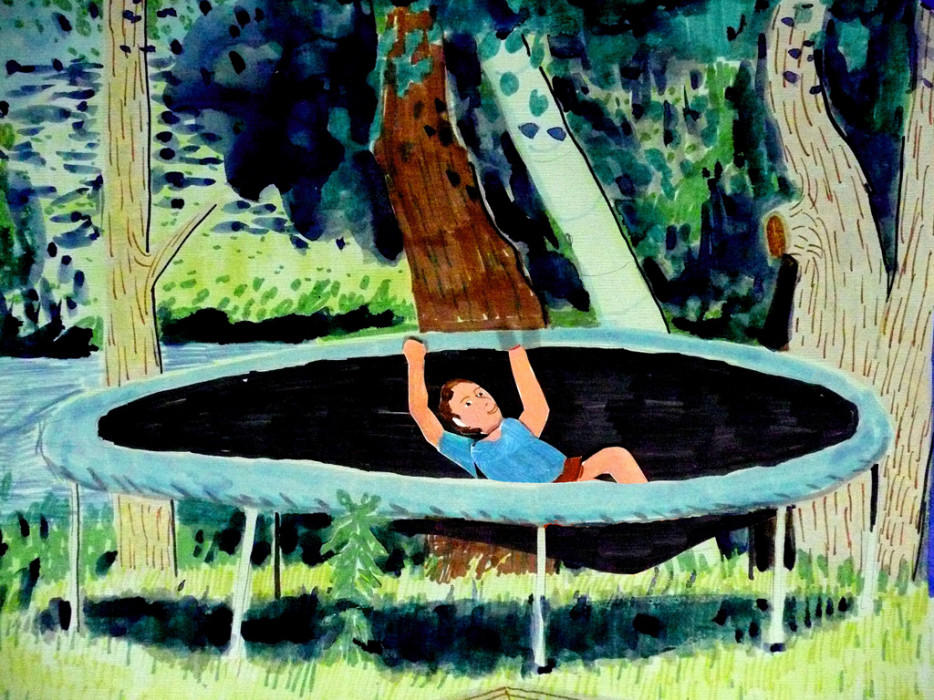Ezra Johnson, Wrestling with the Blob Beast
Launch date: April 17, 2008, Artist Web Projects
Overview
Ezra Johnson presents a collection of screensavers. Animated explorations of painting, Johnson's works range in theme from romantic landscapes or figurative vignettes to meditations on color relationships.
Max OSx and Windows 7 or higher are required. Please note you must be logged in with rights to install software to be able to install the screensaver.
Funding for this series has been provided by the New York State Council on the Arts.
Ezra Johnson, a Brooklyn-based artist, presents a refreshingly diverse range of styles and subjects in the sixteen screensavers that compriseWrestling with the Blob Beast. Whereas painting once implied a fixed image, Johnson uses animation as a new means of looking at paint. InDisturbing the Peace, a painted boat zooms across a painted ocean, moved, as all of these works are, by connections to art and film history.
Derived from painting, the animations cover a wide territory: from representational (a man jumping on a trampoline, leaves falling from the sky) to formal (colored stripes moving vertically, shapes and colors shifting) to a middle ground where figure and abstraction appear to be combined in active battle, as in the title piece, Wrestling with the Blob Beast. In the combination works, a pair of hands shapes and reshapes a blob of paint, which morphs into a dog's face with menacing jaws and then back into paint, a humorous metaphor for the struggles of both process and ideology in painting.
The history of film and cinematic conventions weigh as heavily in their influence on Johnson's work as the history of art. The feeling of camera angle is present in the representational pieces, such as Smoke Signals, which randomly cuts between a view of the sky and a view of a campfire, suggesting a narrative from two perspectives. High and Low and Undercover feel like establishing shots, while First Law of Motion tracks painted lines in long continuous pans ala Hitchcock's film Rope, with the equivalent of cuts occurring at frames of solid color.
Johnson first became known for his 22-minute DVD from 2006, What Visions Burn, the story of a New York art heist, which set painting and film in a loop of self-referentiality. In the course of following the thieves, at one point we see them though a security camera, taking paintings from the museum wall. A delightfully-confusing intertwining unfolds: we are seeing paintings in a film in a painting in a film. As Jan Tumlir wrote in his essay on this work for its presentation at the Hammer Museum in 2007, "cut out of their frames in the museum, transported from one locale to another, changing hands among the film's coterie of shady figures, these "secondary" paintings enact the push and pull of influence and inspiration that every young artist experiences as a clichéd story line."
In all of Johnson's work it is clear that paint is his primary concern, with animation serving as another means of seeing painting rather than as an end in itself. His low-tech process is intentionally transparent: mistakes are left in place at times and the frame rate is slow enough for the viewer to discern how it is made. The process of photographing and repainting repeatedly means his surfaces rarely dry between frames. The three-dimensionality of paint strokes seems almost palpable, even translated to the absolute flatness of a computer screen. In the realm of video and computer-generated imagery on screen, the physicality suggested by these animations provides a compelling shift in sensibility.
Filling a kind of marginal time, screensavers are activated when our attention is not focused on our computers. The screensaver is a paradoxical medium, present when the computer isn't in active use, so presumably not the object of one's focus, yet often running at such lengths that its image becomes indelibly etched in one's visual memory, if only due to a peripheral presence. This unique space and time provide a compelling site for Johnson's short, experimental pieces.
Artist
Ezra Johnson
Ezra Johnson was born in Wenatchee, Washington, in 1975. He lives and works in New York City.
